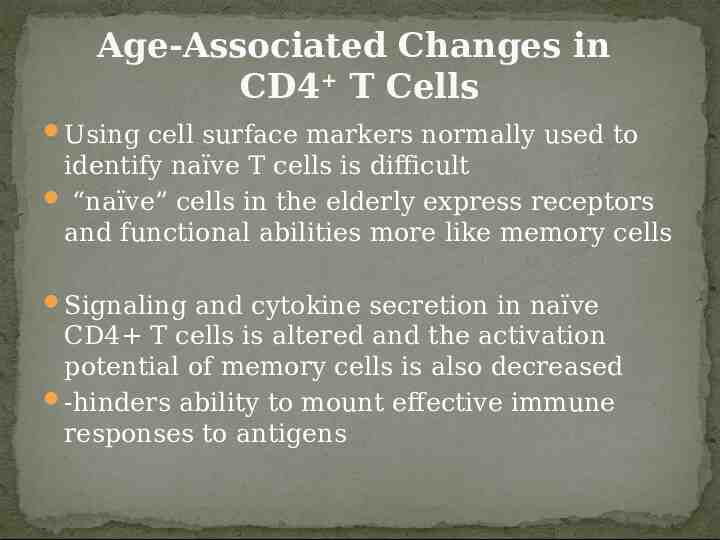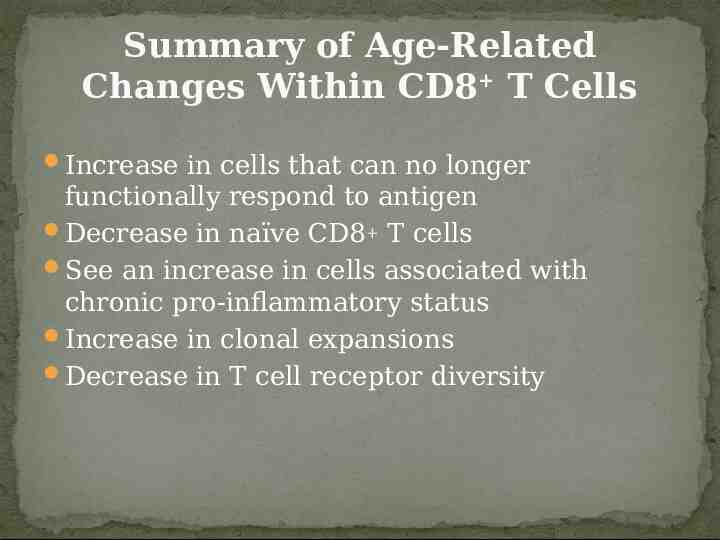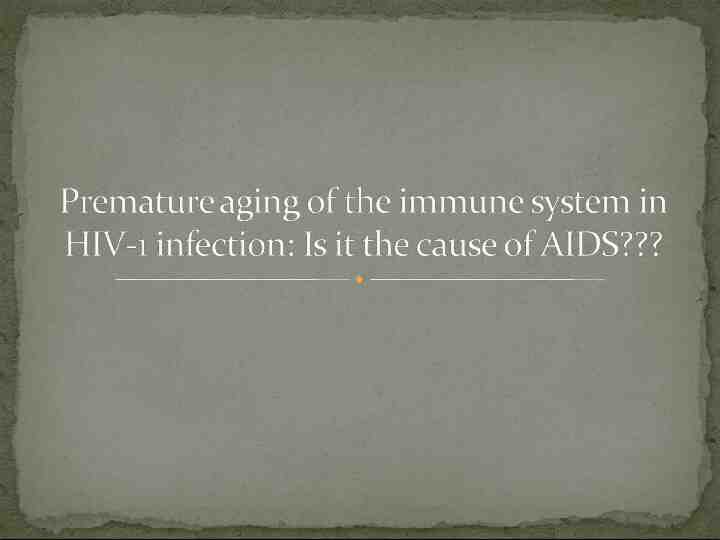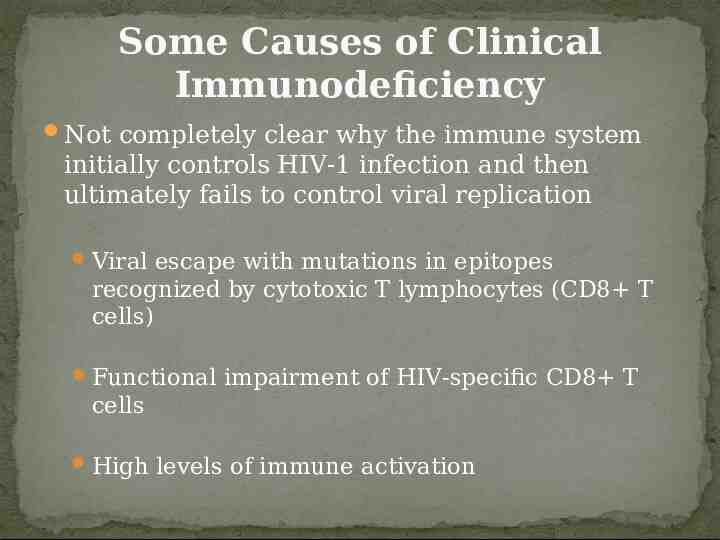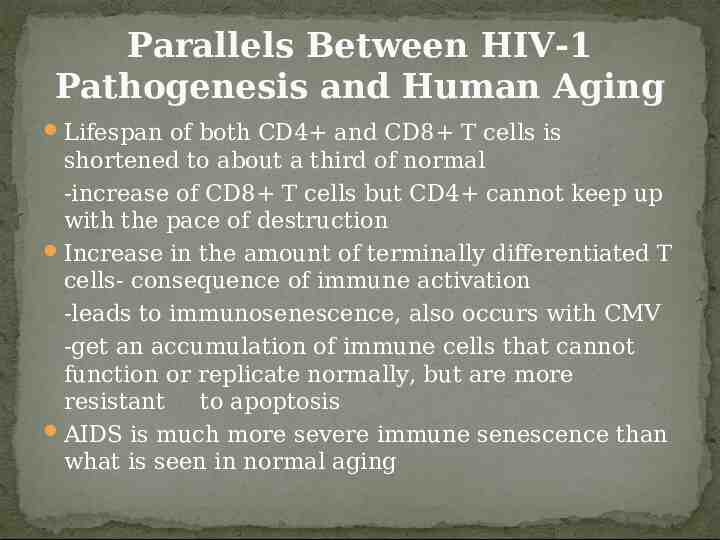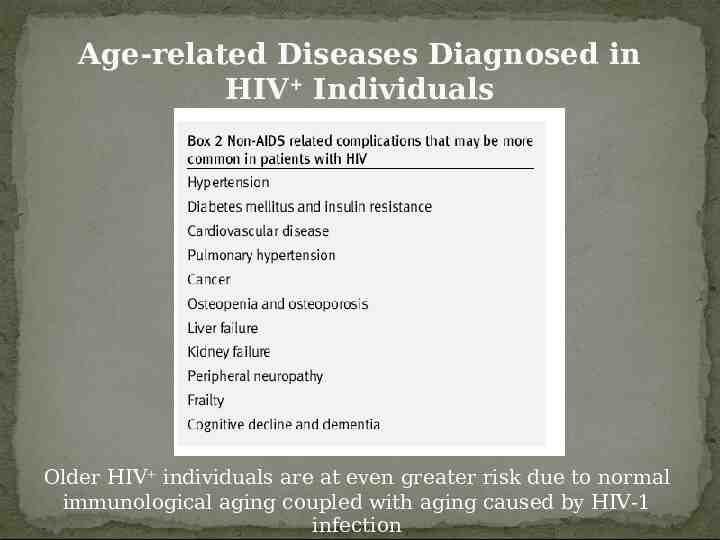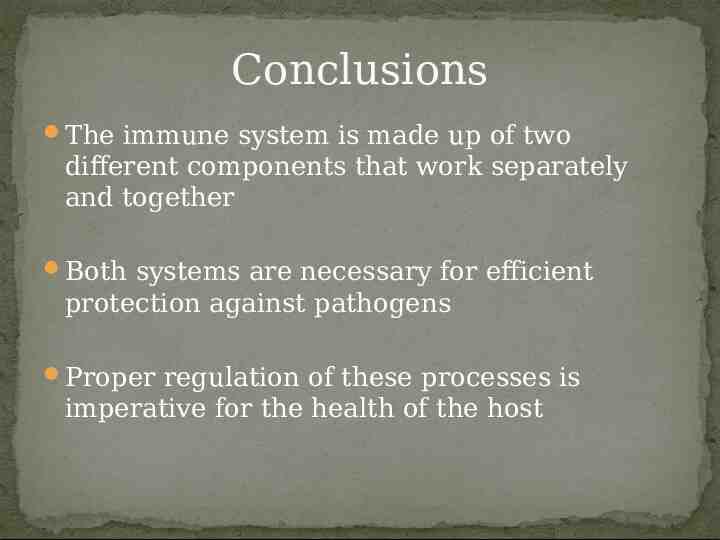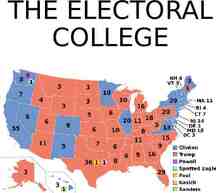In other words………………. how to prevent David from killing Goliath
100 Slides9.34 MB
In other words . how to prevent David from killing Goliath Tammy Rickabaugh, Ph.D. January 14, 2014
2011 Nobel Prize in Medicine IMMUNOLOGISTS!!!!!!! Bruce A. Beutler In 1998 Dr. Beutler identified the cell receptors in mice that respond to a substance in the coat of bacteria and that can set off septic shock if overstimulated. Jules A. Hoffman In 1996, Dr. Hoffmann discovered the cell receptors in laboratory fruit flies that are activated by pathogenic bacteria or fungi. Toll Receptors Ralph M. Steinman In 1973 he discovered the dendritic cell and worked for many years defining its role in adaptive immunity.
I. Two arms of the Immune System A. Innate Immunity B. Adaptive Immunity II. Recognition of Pathogens and Effector Mechanisms III. When things go wrong
Two Distinct Arms of the Immune System Both systems are interrelated Innate Immune system general, attacks pathogens without specificity (generally speaking) -designed to act within minutes of the host being infected - “innate” refers to the fact that the responses do not require time to develop, they are ready to go -use cell receptors that recognize pathogenassociated molecular patterns (PAMPS) -most of our encounters with pathogens and toxins are taken care of by the innate immune system
Cells of the Innate Immune System The main cell types are: -Macrophages -Dendritic cells -Natural killer (NK) cells
Two Distinct Arms of the Immune System The Adaptive Immune System highly specific If the innate immune response cannot control and eliminate pathogens it initiates and mediates the adaptive immune response “adaptive” refers to the fact that it takes time to produce this response Another difference is that once the pathogen is cleared, the cells involved can form “memory” of the pathogen If the organism is infected again with the same pathogen, these cells can mobilize more quickly to defend the host
Cells of the Adaptive Immune System The main cell types are: - T cells - B cells
Two Distinct Arms of the Immune System Pathogens that live in cells are difficult to detect because of accessibility -although infected cells may have altered surface proteins that can be recognized by both the innate and adaptive response Innate immune system -can recognize molecular patterns on the pathogen itself and an infected cell -does not depend primarily on recognizing what pathogen it is
Innate Immune System
Macrophages Macrophage means “large, eating” Their function is to ingest and eliminate infectious agents, process and present antigen (pieces of the pathogen) Help to regulate other immune cells, both innate and adaptive
Dendritic Cells Have a very characteristic shape with long cytoplasmic processes (dendrites) Reside in tissues in an immature form, mature when an infection or injury occurs, induce innate response Mature DC’s can travel to lymphoid organs (lymph nodes, spleen, etc.) with antigen on their surface and act as antigen-presenting cells (APC), very effective Also influence activated T-cells
Natural Killer (NK) Cells Responsible for background in experiments testing the ability of lymphocytes to kill specific target cells Large granular lymphocytes that do not need to be induced or primed to kill cells
Adaptive Immune System
T cells Topnews.in “T”-cells mature in the thymus Two main phenotypic types of T-cells: CD4 T cells (T helper cells) and CD8 T cells (cytotoxic T cells) Responsible for specific recognition of antigens and can retain “memory” of an antigen
B cells Photo: Lennart Nilsson copyright, Material: Anders Rosén Mature in the bone marrow Produce specific antibodies against invading organisms Can differentiate into plasma cells (produce antibody) and retain “memory” of the antigen encounter
Three Defining Characteristics of the Immune System It can discriminate between self and non-self -between host and non-host It remembers what it has encountered (memory) -allows the immune system to react more quickly and effectively to previous pathogens -basis for vaccination Responds only to the pathogen at hand (specificity)
Substances from a pathogen that can trigger an immune response Epitopes: small subregions on the antigen that are recognized by receptors on immune cells -also known as antigenic determinants -one antigen can have many epitopes that can be recognized -can be amino acids, sugars, lipids, or nucleotides Adaptive immunity recognize highly unique epitopes -T-cell specific for an epitope of gp150 in HIV Innate immunity recognize antigens that are not species specific, antigens that are common in a class of microorganism (bacteria, viruses, parasites, etc.)
-Much work is directed at elucidating the nature of antigens and what elicits a good immune response -used to design vaccines and other therapeutics to combat infectious organisms -the H1N1 vaccine, Influenza vaccine
B and T lymphocytes Have surface proteins that recognize only one antigen -very very specific -surface proteins are called antigen receptors - it is the antigen receptors that are responsible for the specificity - T-cell: one small peptide - B cell: usually more than just a small peptide needed Once the antigen binds the receptor, B or T-cell becomes activated and this triggers an immune response
CD8 T-cell CD4 T-cell
http://thyroid.about.com/library/immune/blimm13.htm
Both B and T cell receptors have the ability to recognize any antigen that is encountered -true for synthetic ones also Problem that puzzled scientists for YEARS!!! Why? Because there is not enough DNA in a cell to encode one gene for each possible antibody The answer: combine conserved areas of the receptor (only need a few genes) with highly variable gene segments created by recombining DNA, DNA mutations, etc.
antibody http://flipper.diff.org/app/items/info/1052
T-cell receptor Antibody Copyright 2000, Geoffrey M Cooper http://www.ncbi.nlm.nih.gov/bookshelf/br.fcgi? book cooper&part A828 -It is the variable region that determines the specificity of the receptor -Estimates of the different T-cell and B-cell receptors using various means of recombining are 1018!!!!
B-cell receptor: -recognize antigen in native form (as they exist in nature) -does not need help from other cells to recognize the antigen -true whether or not the antibody is on the surface (receptor) or if it has been secreted from the cell
T-cell receptor: -CANNOT recognize native antigen -can only recognize antigen that has been broken down into epitope sized peptide fragments -antigen has to go through antigen processing -recognizes the peptide and a surface protein on the cell that carries the peptide -surface proteins are called major histocompatibility complex (MHC) proteins -MHC presents the peptide to the T-cell receptor in a process called antigen presentation -T-cells only recognize peptides in the presence of MHC -Antigen recognition by T-cells is said to be MHC restricted and T cells must be histocompatible to be activated
Antigen presenting cell (APC) Macrophages, Dendritic cells, B cells T-cell Appelbaum, et al. Nature 2001
Highly variable from person to person, most variable proteins known Variability is what allows the immune system to distinguish self from non-self MHC Class I- expressed on all nucleated cells MHC Class II-primarily expressed by immune cells -macrophages, dendritic cells, B cells and T cells In humans MHC are also called human leukocyte antigens (HLA) -used to type individuals for bone marrow and organ transplants
There are more than 2100 distinct MHC sequences MHC proteins contain indentations or clefts that can accommodate small peptides (8-11 aa for MHC I and 13-17 aa for MHC II) -the peptides that make up the cleft determine which antigen peptides can bind there Each person inherits one set of class I (A, B, C)and one set of class II (HLA-DR, -DQ and –DP) from each parent -end up with 6 MHC class I and 6 MHC class II receptors that are expressed equally
(February 2003, www3.ebi.ac.uk/Services/imgt/hla/cgi-bin/statistics.cgi). -Peptide binding in the pocket of a MHC-I molecule
MHC class I proteins are primary ones responsible for graft rejection -must be expressed by target cell to be killed by an antigen-specific CD8 T cell MHC class II- all of the “professional” antigen presenting cells express it -macrophages, B cells, dendritic cells
Because of the huge variety, MHC from one individual will interact differently with antigen than another individual A protein from a pathogen contains epitopes A, B, C, D -A person may only present epitope A because of their MHC type and another person may only present epitope B A B D C -Makes it very challenging to immunize T cells in a human population versus B cells (recognize native antigen which is the same for everyone) -Almost all successful vaccines that have been generated depend on B-cell responses rather than T-cell responses
MHC B57 and B27 are associated with better outcomes in HIV infection MHC B35 associated with faster decline of HIV infected individuals MHC HLA-DRB1*091 is associated with better control of Dengue Virus, MHC A*24 is detrimental
When women are given a selection of men’s sweaty t-shirts and asked which smells the most attractive to them, they pick t-shirts from men whose MHC set is most different from their own -kid’s MHC set are more diverse -women on birth control pill can’t discriminate
Natural Killer (NK) cells play a big role in triggering innate immunity -do not have antigen receptors -have surface receptors that inhibit killing function -killer inhibitory receptors (KIRs) -recognize abnormal levels of MHC class I -if a cell has normal amount of MHC class I then NK cells do not kill it -if MHC class I is in lower amounts (some virally infected cells and tumor cells do this) it will be killed
Many viruses interfere with the expression of MHC by the host cell -most likely to avoid killing by CD8 T-cells which use MHC class I to kill cells -NK cells are very important for catching these infected cells -Recently there is evidence that NK cells are helpful in killing cells that over express MHC class I (pre-cancer cells) NK cell (yellow) killing a cancer cell (purple) http://www.nhs.uk/news/2009/09September/Pages/MasterKillerGenes.aspx
Dendritic cells and Macrophages recognize molecules that are common to groups of pathogens -antigen receptors are called pattern recognition receptors (toll-like receptors) -examples of these molecules are carbohydrates and lipopolysaccharides, GpC motifs in bacterial DNA (are not in mammalian DNA) Kumar: Robbins and Cotran Pathologic Basis of Disease, Professional Edition , 8th ed. Copyright 2009 Saunders, An Imprint of Elsevier
Lymphocytes generally exist in the blood in a “resting” state Allows the immune system to send cells where they need to go when a trigger occurs Uncontrolled immune responses can cause damage to the host -need to limit activation and shut it off as quickly as possible
T- and B-cell receptors are anchored in the cell membrane When the antigen receptor binds antigen then the associated molecules are altered to activate the lymphocyte http://bioweb.wku.edu/courses/biol328/TcR.htm http://www.arthritis.co.za/ immunologyupdate.html
The ability of an extracellular antigen to cause activation of intracellular processes across the cell membrane requires signal transduction Usually need more than one signal to do this Second signal is not antigen specific
AP C T cell
B and T cells that have been activated then undergo cell division Give rise to a clonal expansion of just the cells specific to that antigen Called clonal selection and is important for immune control of the reaction
2012 Australian Society for Immunology
Memory cells Schluns , et al. 2003
http://users.rcn.com/jkimball.ma.ultranet/BiologyPages/C/ClonalSelection.html
Very similar to T-cell receptor activation Macrophage signaling NK cell signaling Current Protocols in Cytometry, 2001 http://biology.nd.edu/people/faculty/ schorey/
Chain of Events: 1. Pathogen enters the host 2. Innate immune system is first line of defense -fills lag time and tries lessen pathogen’s strength 3. Adaptive immune response is second -can take several days in a naïve host -low number of specific cells, need to activate and expand
Adaptive Immune Response: -antibody production -activating immune cells and getting them ready to directly or indirectly kill organisms -actually killing the appropriate cells or organisms -regulate all of these functions All done by specific cells with the control of specific cytokines Innate Immune Response: also controlled by cytokines
Small proteins that are similar in function to hormones Control cellular functions over a small distance, in close proximity to the cell that secreted it-paracrine regulation -activated helper T cell secretes a cytokine to help the B cell nearby differentiate into an antibodysecreting cell Can also act on the cell that secreted it- autocrine regulation -activated T helper cell secretes a cytokine that helps it to proliferate and clonally expand
http://trialx.com/curebyte/2011/06/30/clinical-trials-and-images-ofcytokines/
Amount and type of cytokine produced -there are more than 100 cytokines known Level of expression of cytokine receptors on immune cells Different types of cells involved and how quickly they can respond Antibodies that can recognize and bind to the antigens
http://www.biocarta.com/pathfiles/h inflamPathway.asp
Two Types of T cells Helper T cells -Express CD4 on their surface -produce cytokines that help macrophages kill ingested organisms -help B cells to differentiate into antibody producing cells -activate other CD4 cells to expand clonally -help cytotoxic T cells and NK cells kill target cells -cells directly infected with HIV -bind epitopes presented by MHC II Cytotoxic T cells -Express CD8 on their surface -Inhibit other cells or kill them -bind epitopes presented by MHC I
http://www.bio.davidson.edu/Courses/Molbio/MolStudents/spring2003/Cobain/geneprotein.html
Extracellular Immune Effector Mechanisms Extracellular organisms are protected against by: - antibodies (B cells) and phagocytic cells (macrophages) -antibodies are secreted proteins produced by B cells -the antibodies secreted by a particular B cell have the same specificity as the antibody (receptor) on the surface of the B cell
Extracellular Immune Effector Mechanisms - Antibodies bind to whole antigens in their native forms -good defense against bacteria that can grow outside of cells -neutrophils ingest these bacteria but antibody coating makes this easier -they recognize the constant region of antibodies -Opsonization - directly interfere with the replication of pathogens - prevent binding of intracellular pathogens to target cells (HIV)
Process of Opsonization (macrophage )
Different Types of Antibodies
Intracellular Immune Effector Mechanisms Virus infects cell Viral proteins are produced Peptides are carried to cell surface to MHC I Virus-specific CD8 T cells can see this Interaction between MHC I peptide complex and T-cell receptors Cell is killed by T cell This can happen faster than new virus production This is why all cells express MHC I- serves as immune surveillance
http://www.ncbi.nlm.nih.gov/bookshelf/ br.fcgi? book imm&part A1062&rendertype fig ure&id A1063
Intracellular Immune Effector Mechanisms
Intracellular Immune Effector Mechanisms MHC II uses an extracellular pathway as it is loaded with peptides from antigens ingested outside of the cell Used mainly by antigen-presenting cells (macrophages, dendritic cells)
Intracellular Immune Effector Mechanisms Macrophages kill microorganisms they have ingested -need activation by cytokines to help -organisms covered in antibody are helpful -interferon gamma is the best one
Innate Immune Cell Effector Mechanisms NK cells also depend on certain cytokines to make them more effective -IL-2 is needed to differentiate into activated killer cells NK cells kill similar to cytotoxic CD8 T cells -use perforin/granzyme and the Fas/Fas ligand method of inducing apoptosis NK cells also produce cytokines and are important in regulating the immune response Neutrophils and macrophages can ingest antibody coated organisms
Cytokines of Innate and Adaptive Immune System Produced in small quantities and are very short lived They have many different functions and some are redundant They usually bind very tightly to their receptors Cytokine receptors can bind more than one cytokine Very important regulators of the immune response
http://www.biocarta.com/pathfiles/h inflamPathway.asp
Tolerance and Regulation of the Immune Response Immunological unresponsiveness to self is referred to as tolerance or self-tolerance Very important to human health How is this achieved? -cells with receptors for self-antigens are destroyed in the thymus or bone marrow (central tolerance) -self-reacting lymphocytes are made to become non-responsive (anergy) or induced to self destruct (peripheral tolerance) -if this is not balanced well it leads to autoimmunity
Tolerance and Regulation of the Immune Response The immune system also needs to regulate the length and size of a response Long term inflammation is destructive to the host There is a wealth of data showing that chronic immune infections such as CMV and HIV result in premature aging of the immune system Toxic shock syndrome -high numbers of activated T cells produced -huge amount of cytokines produced -leads to shut down of organ systems and sometimes death
Schluns , et al. 2003
Immune Deficiencies B-cell Immune Deficiency -host cannot make antibodies -present with recurrent bacterial infections -opsonization does not occur, phagocytes cannot compete with growing bacteria
Immune Deficiencies T-Cell Immune Deficiencies -recurrent infections with parasites, viruses and intracellular bacteria -see this in transplant patients suppressed to prevent rejection -seen in HIV infection which is known to deplete CD4 T-cells
Immune Deficiencies NK Cell Immune Deficiency - initially thought to not have clinical importance -13 year old girl presented with life-threatening chicken pox infection -had history of recurrent ear infections, disseminated CMV infection, herpes simplex virus infection with rash, etc. -had no NK cells!!! -important in controlling herpes virus infections -herpes viruses are known to downregulate MHC I so NK cells are important in controlling infection
Autoimmunity Autoimmune diseases: -Diabetes, Rheumatoid Arthritis, Lupus, Multiple Sclerosis Thought that regulation of the immune system is involved, not just self-reactive lymphocytes Some genetic factors involved -certain MHC alleles -more women than men affected May be triggered by infectious organisms with antigens similar to normal host antigens
http://ashpauls.wordpress.com/autoimmune-diseases/
H1N1 Why was it deadly? -in some individuals they developed Acute Respiratory Distress Syndrome -due to the huge immune response and inflammation that was triggered by the virus Why were elderly not at as much risk? -appears there was a flu epidemic that they may have been exposed to that gave their immune system some “memory” against H1N1
Effects of Aging and HIV on the Immune System
Aging Elderly people are more susceptible to infections Less protected by vaccines Infections in the elderly are characterized by more severe symptoms, longer duration, and poorer prognosis Reactivation of Varicella-Zoster, risks for pneumonia, urinary tract infections, meningitis, TB and viral gastroenteritis Related to age-related changes in the immune system
The Human Thymus Involutes With Age Fetal Thymus Adult Thymus Jamieson, BD, et al, Immunity, 1999
Age-Associated Changes in CD4 T Cells Using cell surface markers normally used to identify naïve T cells is difficult “naïve” cells in the elderly express receptors and functional abilities more like memory cells Signaling and cytokine secretion in naïve CD4 T cells is altered and the activation potential of memory cells is also decreased -hinders ability to mount effective immune responses to antigens
Age-Related Changes Within CD4 T Cells Kovaiou, Grubeck-Loebenstien, 2006
Summary of Age-Related Changes Within CD8 T Cells Increase in cells that can no longer functionally respond to antigen Decrease in naïve CD8 T cells See an increase in cells associated with chronic pro-inflammatory status Increase in clonal expansions Decrease in T cell receptor diversity
Some Causes of Clinical Immunodeficiency Not completely clear why the immune system initially controls HIV-1 infection and then ultimately fails to control viral replication Viral escape with mutations in epitopes recognized by cytotoxic T lymphocytes (CD8 T cells) Functional impairment of HIV-specific CD8 T cells High levels of immune activation
The Adaptive Immune System in Aging and HIV-1 Infection Appay, V and Rowland-Jones, SL, Trends in Immunology, 2002
Parallels Between HIV-1 Pathogenesis and Human Aging Lifespan of both CD4 and CD8 T cells is shortened to about a third of normal -increase of CD8 T cells but CD4 cannot keep up with the pace of destruction Increase in the amount of terminally differentiated T cells- consequence of immune activation -leads to immunosenescence, also occurs with CMV -get an accumulation of immune cells that cannot function or replicate normally, but are more resistant to apoptosis AIDS is much more severe immune senescence than what is seen in normal aging
Age-related Diseases Diagnosed in HIV Individuals Older HIV individuals are at even greater risk due to normal immunological aging coupled with aging caused by HIV-1 infection
Conclusions The immune system is made up of two different components that work separately and together Both systems are necessary for efficient protection against pathogens Proper regulation of these processes is imperative for the health of the host
THE IMMUNE SYSTEM IS INCREDIBLY COOL!!!!!! [email protected]


























































































